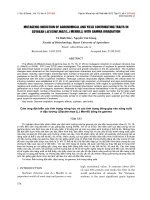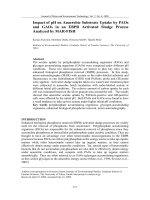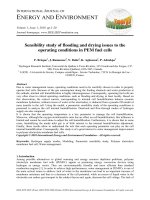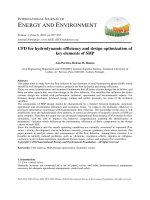Genetics in minutes 200 key ideas of evolution and biology in an instant
Bạn đang xem bản rút gọn của tài liệu. Xem và tải ngay bản đầy đủ của tài liệu tại đây (24.76 MB, 414 trang )
CONTENTS
Title Page
Introduction
Life
Inheritance
The cell
DNA
Sex
Evolution
Classification
Ecology
Animal relationships
Neo-Darwinism
Origins of Life
Humans and genetics
Genetics and technology
Glossary
Picture credits
Copyright
About the Author
Other Titles in the Series
About the Book
Introduction
n its simplest terms, genetics is the study of inheritance. However, looking a little
deeper, there is nothing simple about it. Genetics tells us how a body can grow from a
single cell; it shows how life on Earth has changed in a myriad ways over billions of years;
and it forms a central plank in the fight against disease. What’s more, it also has the
potential to create new technology that will transform society, ensuring health for all and
perhaps even allowing us to control the future development of our species and reshape
the living world.
I
As a science, genetics is relatively new: its foundations date from the 1850s, but those
many different strands were not drawn into a single field until the early 20th century. It
was slow going at first, and not until the 1950s did the great mysteries of genetics begin
to give up their meanings. First was the discovery of the DNA double helix, and after that
the so-called ‘Central Dogma’, which shows how an inanimate chemical code can result
in a living body. Progress accelerated rapidly as we unlocked more of the secrets of the
gene, but even today, despite huge advances, there are many riddles within our DNA that
we are still to solve. We may have learned how to decipher the genetic code, but the
work of translating what it all means is still proceeding.
Genetics draws from many fields, such as chemistry, biology, agriculture, engineering,
even information theory and statistics. For many, the expectation is that genetics can tell
us exactly who we are, what’s ‘in the genes’. Long before the science of genetics
existed, our ancestors would have understood that a child was a unique blend of
characteristics inherited from its parents. However, the extent to which the nature of our
genetic code rules our behaviours and personalities is proving the most difficult puzzle to
solve. Perhaps the latest interests of genetics, such as stem cell research, epigenetics
and artificial biology, will provide those missing pieces – certainly these intriguing areas of
research suggest that genetics will continue to have a huge influence on medicine and
our understanding of what it means to be human in the 21st century and beyond.
Life
hat is life? In a nutshell, scientists would define it as a self-replicating process that
requires at least one ‘thermodynamic cycle’. To put that another way, something
that is alive is able to make a copy of itself, and it does this by harnessing a source of
energy, using it to transform chemical resources in some way. The supply of energy
must be continuous; if the energy source were to become unavailable, or the life form
became unable to tap it, then the result would be death. That is something else unique
that life can do: it can die.
W
According to this definition, the simplest life form is a strand of nucleic acid, something
like RNA (see here). This chemical is able to use its own molecule as a template for a
copy of itself. However, such a life is incredibly precarious, and over billions of years of
evolution, a multitude of life forms have developed abilities that ensure survival. These
abilities are set out in genes, and they govern the success or failure of a life. To
understand life, one must begin with genetics.
Types of organism
he number of different types, or species, of organism on Earth is estimated to be
anywhere between 3 and 30 million, with most biologists erring towards about 9
million.
T
The simplest and oldest life forms are the bacteria, which have a body made from a
single tiny ‘prokaryotic’ cell (see here). They are joined by the archaea, which to the
uninitiated look more or less the same but have some important distinctions. Other
single-celled organisms, including things like amoebae and protozoa, have much larger and
more complex cells, and this ‘eukaryotic’ cell type (see here) is the one used by
multicellular organisms such as plants, animals and fungi.
Every species of organism has a unique way of life, but members of any biological group
share more characteristics with each other than with the members of other groups.
However, all life forms share a set of abilities: they sense the surroundings, excrete,
reproduce, grow, respire and require nutrition.
Metabolism
he broad term ‘metabolism’ encapsulates the link between chemical activity and life –
the myriad chemical processes that are occurring inside every organism are described
as its metabolism. In very general terms, these include the way the organism handles its
energy supply, and how it uses this to grow and repair its body, making use of simple
chemical building blocks.
T
Metabolic processes fall into two general types: anabolism and catabolism. The former
involve building larger, more complex and more ordered structures out of smaller units.
(That is why a sports cheat might use an ‘anabolic steroid’, a chemical that builds
muscle.) Catabolism, in contrast, involves splitting large structures into smaller ones (this
includes processing unwanted waste materials to generate energy). Anabolic and
catabolic processes are constantly working together to release manageable packets of
energy and then put them to work in keeping the organism alive.
Feeding
very living thing must feed, or putting it more precisely, they must access a source of
nutrition. Plants get this in the form of sugars from photosynthesis and mineral
nutrients absorbed from their surroundings (soil is a good place to start). Animals and
fungi get their nutrition from the bodies of other organisms. Some single-celled organisms
can get nutrition using both techniques!
E
Nutrition has two main purposes. First, it is a source of chemical energy that can be
extracted and put to work in the body (the best examples of this are glucose and other
sugars). The second purpose is as a stockpile of the raw ingredients required to build a
body. The requirements of different organisms vary wildly: plants are able to build
everything they need from water, carbon dioxide, and a menu of minerals such as
nitrates and phosphates, while animals need more complex nutrition, such as fats,
starches, proteins and a range of crucial helper chemicals, known collectively as
‘vitamins’.
Respiration
hen most people hear the term ‘respiration’, they tend to assume it relates to
breathing. But while this is indeed the word’s common medical context, biology
gives it a wider meaning: in fact, all organisms respire, whether or not they breathe in and
out in the way that vertebrate animals do.
W
Biologically, respiration is defined as the metabolic process that releases energy from
sugar or other chemical fuels. Typically, this involves the fuel molecules being oxidized –
exactly the same chemical reaction involved when materials combust in air. The
respiration of glucose, one of the most common sugars, for example, can be written in
the form of a chemical equation as shown opposite. This demonstrates that glucose
reacts with oxygen to produce carbon dioxide and water, plus some energy. If raw
glucose is burnt in air, the reaction produces flames and heat, but within a living cell it can
be heavily regulated, allowing small packets of energy to be released in several steps.
Photosynthesis
s the word suggests, ‘photosynthesis’ is the process of ‘making with light’, and the
end product in question is glucose sugar. Photosynthesis takes place in the leaves and
the other green parts of plants and other photosynthetic organisms. The colour is
important because the energy from sunlight is absorbed by a pigment chemical called
chlorophyll in the plant’s cells – chlorophyll itself appears green because it traps the blue
and red wavelengths of sunlight while reflecting other colours.
A
Chemically, photosynthesis is the reverse of respiration, with carbon dioxide and water
molecules being combined to make glucose molecules and oxygen, all powered by the
energy channelled from the chlorophyll molecules. While carbon dioxide is the waste
product of respiration, photosynthetic organisms produce waste oxygen, which is
released into the air. Nearly all of the oxygen in Earth’s atmosphere (about 20 per cent of
all the air) originated as the by-product of photosynthesis.
Growth
o qualify as living, an organism needs to be able to grow – at least at some point in its
life. For most complex organisms this is a simple thing to verify. The majority of
multicellular life forms – those with bodies of more than one cell – grow from a single cell
into an embryo and on to a fully developed adult. This growth is achieved by the division
of cells (see here and here), with every cell in the body being descended by some route
from that first single cell, known as the zygote.
T
The growth of single-celled organisms – things like bacteria and amoebae – is less clear
cut. They too can divide their cells, but instead of creating a larger body, they produce a
new and independent individual. In these cases, growth and reproduction are two sides
of the same coin. Therefore, the best definition of growth is the ability to produce new
cells from older cells. This is the concept that lies at the heart of cell theory (see here), a
central tenet of life science.
Reproduction
t could be said that the primary goal of an organism is to survive. However, that survival
is really a means to an end – all organisms are striving to make a copy of themselves or
something close to it. In other words the true purpose of biological life is reproduction.
There are many modes of reproduction, ranging from organisms simply dividing in two to
a complex process of courtship, mate selection and parental care. However, broadly
speaking there are two types of reproduction: sexual and asexual. The former involves
two parents and the latter requires only one (see here and here).
I
The struggle to survive and reproduce is the driving force behind evolution by natural
selection (see here), the process that shapes the millions of species that live on Earth.
However, this evolution is a by-product of reproduction. The genetic purpose of
reproduction is to make new copies, and many of them, of the DNA molecules in all
bodies, reproducing the information that we call genes.
Excretion
ust as an organism takes in nutrients and other raw materials from its surroundings, it
must also remove the waste products of metabolism – a process known as excretion.
Despite common usage, the voiding of the bowel, passing faecal matter, out of the body
is not actually excretion in biological terms: instead, it is defecation or egestion. The
crucial difference is that the unused food has not really entered the body – it has only
passed through the gut, a hollow tube that runs through the body. True excretion is the
process of taking waste products – which may be harmful if left to accrue – from the
body’s tissues and expelling them.
J
In human biology the chief mode of excretion is urination, whereby excess water and
nitrogen-rich waste in the form of urea are released. Excretion can also occur directly
through the skin as sweating. In addition, the release of carbon dioxide generated by
respiration processes is also a form of excretion.
Senses
ll life forms are able to detect changes in their surroundings and respond to them. For
single-celled organisms this may be simply a matter of detecting a chemical change,
such as the salinity of water or the presence of nutrients or toxins. Plants, meanwhile,
are sensitive to light, gravity and sometimes pressure – they grow towards light and
away from the pull of gravity, and some adjust their growth patterns to wrap themselves
around other objects they contact.
A
Animal senses are much more advanced, befitting their active lifestyles. The five used by
humans are somewhat ubiquitous: hearing, smell, taste, vision and touch. The last of
these is a complex mix of detectors on the body surface, sensitive to heat, cold,
vibrations and pressure. Other animals can sense things beyond a human’s abilities. Many
insects and other arthropods can detect ultraviolet light; sharks and their cousins can
detect electrical activity in another body, while many other animals appear to sense
Earth’s magnetic field.









